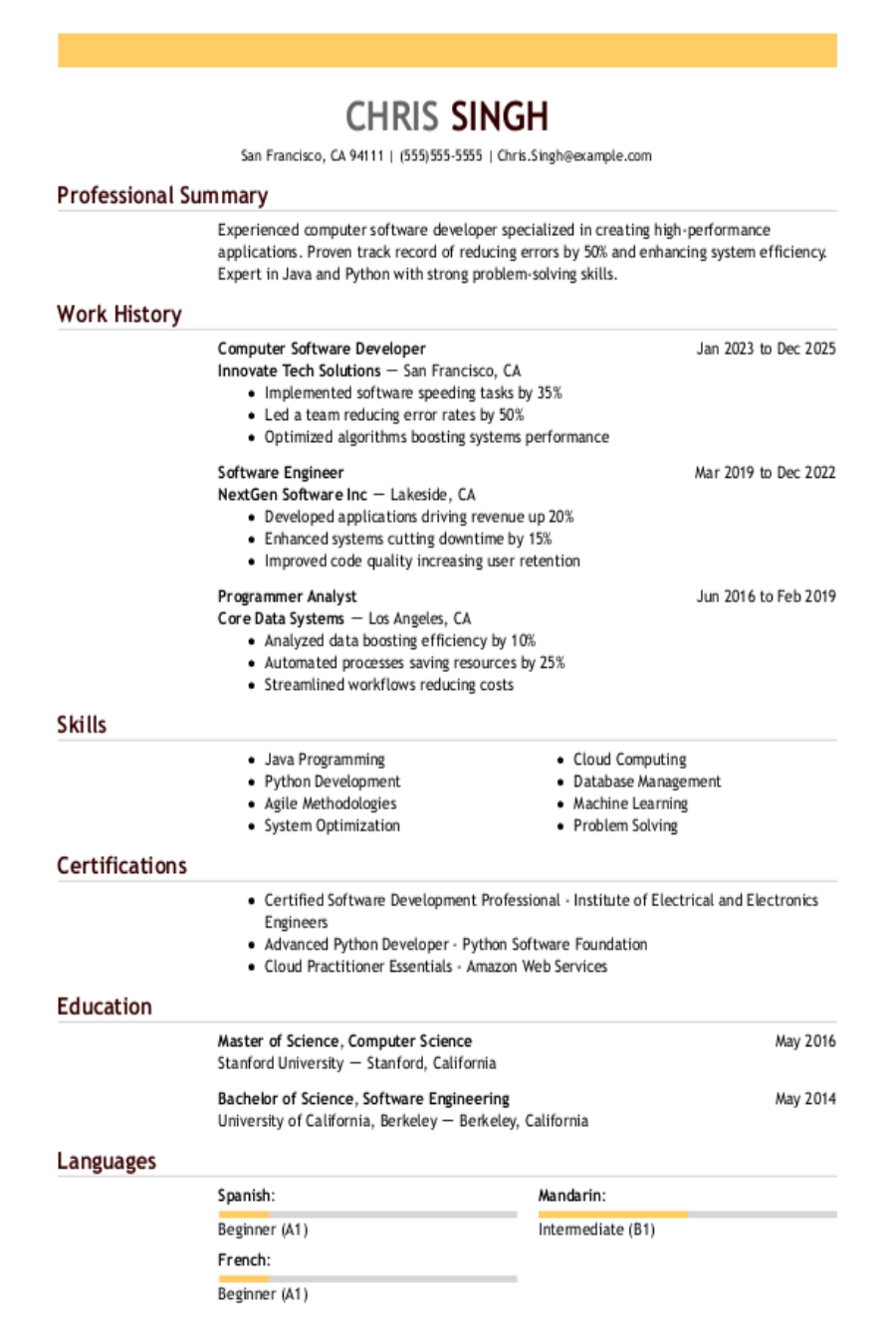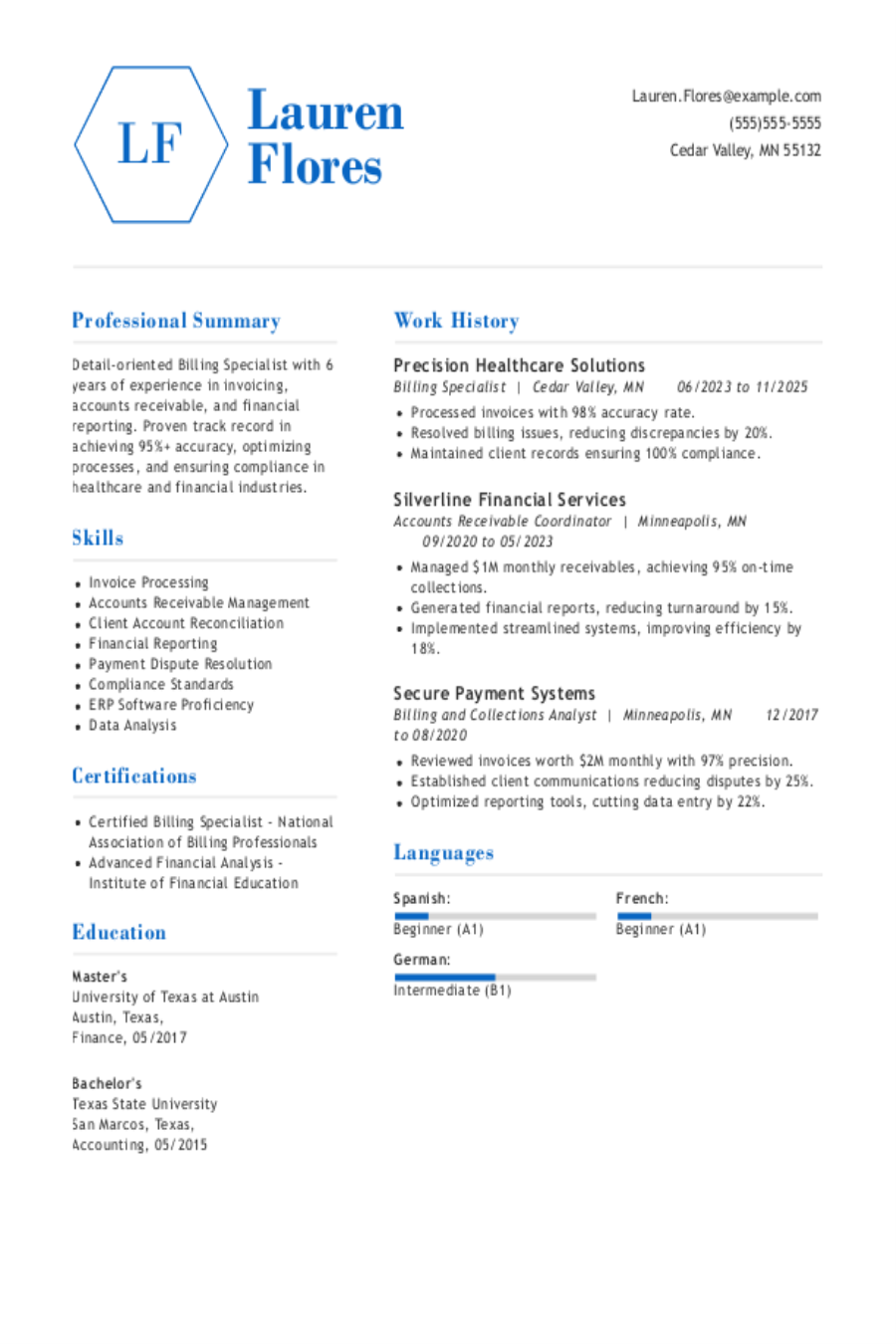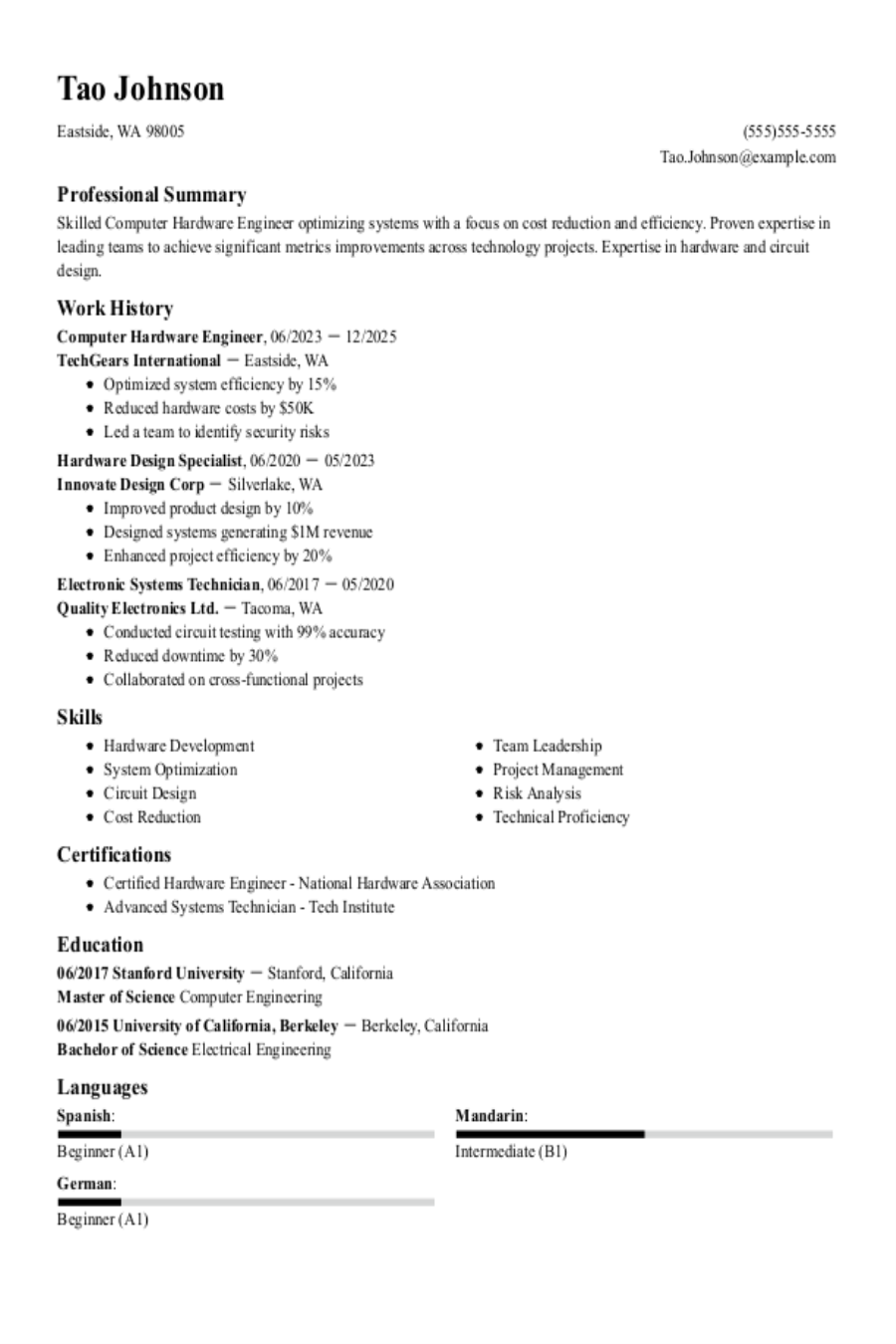Popular Production Editor Resume Examples
Entry-level production editor resume
An entry-level resume for a production editor should focus on relevant coursework, internships, technical skills in editing software, and strong attention to detail to demonstrate readiness for the role.
Places skills over experience: Using a functional resume format strategically highlights this candidate's editing skills and project management experiences, such as improving manuscript clarity by 30%, rather than focusing solely on their work history.
Emphasizes soft skills: This resume highlights soft skills like team leadership and project management, which effectively compensate for limited experience.
Mid-career production editor resume
A mid-career production editor resume should emphasize a combination of editorial experience, technical skills, and continuous professional growth to attract attention from potential employers in the publishing industry.
Balances skills and experience: This applicant's resume effectively showcases a strong mix of technical skills in content management and editorial oversight alongside notable career advancement from an editorial assistant to a production editor, highlighting impressive achievements.
Begins with a powerful summary: This resume's professional summary highlights the applicant's extensive experience in production editing and project coordination. This clarity helps recruiters and ATS quickly pinpoint relevant qualifications and accomplishments.
Experienced production editor resume
An experienced production editor resume should emphasize showcasing editing expertise and project leadership while clearly outlining professional achievements and growth in the publishing industry.
Optimized for ATS: The resume showcases a polished template that effectively integrates a professional header with an ATS-friendly resume design, ensuring it appeals to both human recruiters and automated tracking systems.
Quantifies achievements: Quantifiable achievements significantly strengthen a job seeker's profile by providing concrete evidence of their impact. By highlighting metrics like error reduction rates and productivity increases, recruiters can easily grasp the value this applicant brings to potential employers.
No experience production editor resume
A resume for an applicant with no experience should emphasize relevant skills, coursework, and projects that demonstrate the job seeker's ability to manage content effectively and creatively.
Overcomes lacking experience: Incorporating relevant volunteer work related to advanced editing and digital publishing illustrates the applicant's strong foundation in editorial practices. This effectively demonstrates readiness for a production editor role, even with limited direct experience.
Emphasizes professional skills: Highlighting professional skills like content editing and project management, the job seeker showcases readiness to excel as a production editor despite limited experience.
More resume examples
Production Editor Resume Template
Looking to create a standout application? Use this production editor resume template as your base—simply personalize it with your own details and experience.
Michael Kim
Crestwood, KY 40019
(555)555-5555
Michael.Kim@example.com
Professional Summary
Experienced production editor with expertise in content optimization, digital publishing, and project management. Proven track record in reducing errors, enhancing efficiency, and leading teams with improved workflows.
Work History
Production Editor
Content Innovations Ltd. - Crestwood, KY
June 2023 - October 2025
- Reduced errors by 25% through optimized proofreading.
- Managed production of 50+ monthly publication projects.
- Coordinated with 15+ authors and editors globally.
Editorial Coordinator
Bright Media Group - Louisville, KY
January 2019 - May 2023
- Enhanced workflow efficiency by 40% using new tools.
- Led team to achieve 98% project deadlines on time.
- Implemented CMS improvements saving $10K annually.
Publishing Assistant
Slate Publishing House - Louisville, KY
October 2017 - December 2018
- Assisted in editing 100+ manuscripts yearly.
- Increased social media engagement by 15%.
- Supported 10+ onsite and virtual events.
Education
Master of Arts Publishing
University of Texas at Austin Austin, Texas
May 2017
Bachelor of Arts English Literature
Texas A&M University College Station, Texas
May 2015
Skills
- Content Management Systems
- Proofreading and Editing
- Project Management
- Publication Design
- Digital Publishing Tech
- Adobe InDesign
- SEO Content Strategies
- Collaborative Communications
Certifications
- Certified Digital Editor - American Society of Journalists and Authors
- Advanced Publishing Techniques - Publishing Standards Institute
Languages
- Spanish - Intermediate (B1)
- French - Beginner (A1)
- German - Beginner (A1)
Writing Your Production Editor Resume
Having explored these impressive resume examples, you are now equipped to dive into the process of crafting your own. We'll walk you through how to write a resume step by step, breaking down each section for clarity and effectiveness.
List your most relevant skills
A great skills section for your production editor resume should highlight both your technical abilities, like editing software skill, and soft skills such as attention to detail and time management. These elements will give recruiters a clear picture of your capabilities.
Incorporating keywords from the job listing into this section is important. Doing so not only aligns you with the specific needs of potential employers but also helps ensure that applicant tracking systems recognize you as a strong job seeker. This strategy improves your visibility and increases your chances of landing an interview.
Example of skills on a production editor resume
- Proficient in managing editorial workflows and timelines for timely project completion
- Adept at collaborating with writers to refine content and improve clarity
- Strong analytical skills for evaluating content quality and consistency
- Excellent communication abilities to facilitate team discussions and feedback
A well-crafted skills section is essential to showcase your readiness for the production editor role. Highlight both technical skills mentioned in the job description and relevant soft skills, which demonstrates that you possess the complete skill set needed to excel in this position.
Highlight your work history
A compelling work experience section should showcase how you've applied your editing skills and improved processes, ensuring that each entry is infused with relevant keywords to catch the eye of hiring managers.
For every job entry, include key details such as your title, the employer’s name, and the dates you were employed. This information helps establish your professional credibility and allows employers to quickly gauge your background in the industry. Remember to emphasize specific accomplishments that demonstrate how you added value to each role.
Example of a production editor work experience entry
- Production Editor
HarperCollins Publishers - New York, NY
June 2019 - August 2023 - Managed the editorial process for over 50 book titles annually, ensuring timely delivery and adherence to quality standards
- Collaborated closely with authors and illustrators to refine manuscripts, improving narrative clarity and engagement
- Led a team of five junior editors, fostering skill development through ongoing mentorship and training sessions
- Implemented a streamlined workflow that reduced production time by 15%, improving overall efficiency in the department
- Conducted detailed market research to inform strategic content decisions, contributing to a 10% increase in publication reach
Quantifying achievements as a production editor is vital to illustrate your impact on projects. For example, stating that you reduced editorial errors by 40% in a year not only highlights your attention to detail but also demonstrates your contribution to overall quality improvement.
Add portfolio work to your resume
As a production editor, your resume should effectively highlight your editing skills while inviting hiring managers to explore your portfolio. The challenge lies in showcasing your work without overwhelming readers, so striking the right balance is key.
Place a link to your portfolio prominently at the top of your resume, ideally near your contact details. Consider adding a "selected works" section where you briefly describe 3-4 standout projects that demonstrate your editorial expertise and impact on production timelines or quality.
Example of a portfolio highlights section
- Editorial Review for Modern Living Magazine – Improved article clarity and flow, resulting in a 20% increase in reader engagement metrics
- Content Development for Tech Innovations Weekly – Collaborated with writers to produce high-quality content that led to a 15% rise in subscription rates
- Style Guide Creation for Health & Wellness Digest – Established comprehensive guidelines that improved consistency across publications recognized by industry peers
- Proofreading and Formatting for Academic Journal of Science – Ensured accuracy and adherence to formatting standards, contributing to timely publication
Include your education
In your production editor resume, the education section should display your academic qualifications in reverse-chronological order, starting with your most recent degree. If you hold a bachelor's degree or higher, it’s advisable to leave out your high school diploma. You should include relevant courses or certifications that demonstrate your expertise in editing and production.
For those who are currently pursuing a degree or have not yet completed their education, indicate the highest level achieved along with an expected graduation date. Highlighting key coursework or projects relevant to the role of a production editor can be beneficial for recent graduates entering the field.
Common certifications for a production editor resume
- Certified Production Editor (CPE) – American Society of Editors (ASE)
- Editing Certificate – University of Washington
- Professional Editor Certification (PEC) – Editorial Freelancers Association (EFA)
- Certificate in Editing – Simon Fraser University
Sum up your resume with an introduction
A strong profile section on your resume serves as your personal introduction, making a compelling first impression on potential employers. It’s a concise summary that showcases your skills and sets the tone for what follows in your application.
For experienced job seekers, a professional summary is the right approach. This format allows you to highlight key achievements and relevant experiences right at the top of your resume. If you have little experience, create a resume objective centered on your professional development goals.
Professional summary example
Accomplished production editor with over 5 years of experience in the publishing industry. Demonstrated success in improving editorial quality, managing tight deadlines, and leading cross-functional teams to deliver engaging content. Expertise in manuscript evaluation, content development, and adherence to style guidelines ensures top-notch publications.
Resume objective example
Enthusiastic production editor eager to use strong attention to detail, creative problem-solving abilities, and effective communication skills to improve content quality in a collaborative environment. Committed to fostering engaging narratives that resonate with audiences while contributing positively to project timelines and team objectives.
A strong resume profile is your initial chance to showcase essential keywords that align with the production editor role. Analyze job descriptions carefully and weave in relevant terms to improve your visibility in applicant tracking systems. This strategic approach can significantly boost your chances of standing out to potential employers.
Add unique sections to set you apart
Improve your resume by including optional sections that highlight your unique qualifications for production editor roles. These areas allow you to showcase the skills and experiences that set you apart from other applicants.
Consider adding sections for relevant hobbies or volunteer work, as they reveal important aspects of your professional identity. For instance, if you’ve volunteered in media literacy programs or have a passion for editing podcasts, these experiences can demonstrate your commitment to storytelling and communication.
Three sections perfect for a production editor resume
- Work Samples: A portfolio section is essential for a production editor’s resume, as it highlights your editorial skills and project management experience. Include 3-5 standout projects that showcase your contributions, problem-solving abilities, and the impact of your work on overall production quality.
- Client Testimonials: Incorporating client testimonials into your resume can set you apart in a creative field. Use compelling quotes that showcase your unique skills and accomplishments, demonstrating how you've exceeded expectations and delivered outstanding results.
- Awards and Recognition: Incorporating awards on your resume can improve your credibility. Include relevant achievements, such as industry accolades or certifications, along with the granting body and date to highlight your expertise.
5 Resume Formatting Tips
- Choose a format that matches your career stage.
Choosing the right resume format is important for showcasing your skills effectively. If you have extensive experience, using a chronological format highlights your career progression. For those just starting out, emphasizing your skills over work history with a functional resume can be more effective. Consider mixing both approaches with a combination format if you have some experience but want to showcase specific skills.
- Pick a smart resume template.
Using a resume template is key to improving readability and ensuring your content stands out. Choose a layout that highlights your strengths and makes it easy for hiring managers to scan your information. If you opt for a custom format, keep it clean and use fonts that are compatible with applicant tracking systems.
- Select an appropriate font.
Choose from clean, professional font styles like Helvetica or Georgia to create a strong first impression and ensure that your resume is easily readable by ATS systems and recruiters.
- Use consistent formatting.
Align your resume to the left and maintain uniform margins. This creates a clean, organized look that improves readability and presents a professional image.
- Keep your resume to one or two pages.
When crafting your resume, remember that resumes should be one page long. If you have extensive experience, a second page can be acceptable. Keep your content concise and ensure it highlights the most relevant information to grab attention.
Tools for Your Job Search
Are you ready to apply for that production editor role you've been dreaming about? Before you hit submit, consider using our ATS Resume Checker. This essential tool provides insights into how your resume performs against the automated systems that many publishing companies use to screen applications.
Looking to elevate your resume further? Our AI Resume Builder offers tailored recommendations specific to your editorial experience, along with professionally designed templates that effectively showcase your skills and achievements to potential employers.
Frequently Asked Questions
Last Updated: October 28, 2025
Absolutely. A cover letter is important because it adds depth to your resume and allows you to communicate directly with employers. This is your opportunity to express your enthusiasm for the role and demonstrate how your unique skills make you the right fit. Don’t hesitate—write a cover letter that stands out!
For a quick and effective solution, consider our AI Cover Letter Generator. It helps you create tailored cover letters in just minutes, complete with various cover letter template options that will match your resume perfectly. Start improving your job application today!
A CV (curriculum vitae) is generally longer and more comprehensive than a resume. Resumes are typically concise, spanning one to two pages, while CVs can extend several pages and detail your academic background, research contributions, publications, and extensive professional experiences.
When applying for roles in academia, science, law, or medicine, you should use a CV. If you need to craft a tailored CV for your application, our online CV Maker is an excellent solution. It allows you to choose from various CV templates designed for different industries and career levels—making the process quick and efficient.
To make a standout production editor resume, select a polished template and seamlessly integrate relevant keywords from the job description. This strategy ensures your qualifications shine and align with employer expectations.
A frequent mistake production editors make is submitting resumes that aren’t optimized for ATS. To improve your chances of getting noticed, choose a resume template that's ATS-friendly and tailor your resume to align with the specific job description. This increases the likelihood of passing through automated screenings.
As a production editor, showcasing your dedication to growth is essential. You can do this by obtaining relevant certifications and listing any courses you've completed. Attend seminars and read industry-related books to stay informed. Engaging with podcasts tailored to editing or publishing will also improve your knowledge. Lastly, join professional associations to connect with peers and demonstrate your commitment to the field.
Was this information helpful? Let us know!
Hailey is a career advice writer dedicated to helping job seekers excel in their careers.
More resources

How to Make a Canadian Resume (Format, Template + Examples)
Creating a Canadian resume is key to getting a job in Canada. ...

How to Write a Resume for an Internal Position (Guide + Examples)
Ready for a new role within the same company? We ll help you...

The Great Workplace Reckoning: How 2025 Burned Out Workers & What’s Next for 2026
The workforce spent much of 2025 in survival mode navigating ...

Interview-Winning Computer Software Resumes Examples and Tips
Was this information helpful? Let us know ...



